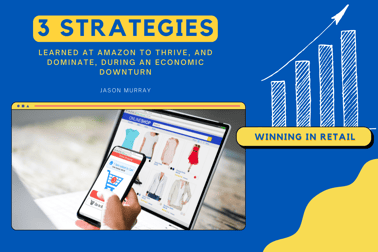How to Thrive During Economic Downturn: Amazon's Playbook

The downturn is real and it’s going to get worse before it gets better.
This single, scary issue was the elephant in the room and the big theme that hung over every retail attendee at the National Retail Federation event this week. Yet despite this, open and direct conversations about how to prepare for a recession were absent from keynotes, sessions and broader discussions.
I get it - it’s hard to admit that after a record breaking, once-in-a-lifetime ecommerce bonanza in 2020-2021 (thank you, COVID-19) we’re not just returning to normal, we are on a collision course with a recession in 2023.
Retailers have a decision to make; get defensive and expect customer demand to tank, or follow the playbook that we created at Amazon during the financial crisis of 2008 that helped us dominate online sales for the past twenty years.
Navigating a downturn; What I learned in 19 years at Amazon
Now is the time to play offense and invest in the right technologies that will improve operations and set you up for success. It might sound counter intuitive, but this is the single most important mindset that I took away from nearly two decades building and managing retail and logistics technology at Amazon. It’s the most important bit of advice I can give retail, ecommerce and DTC brands now and in the future.
As the US collapsed financially in 2008, we invested in three strategic principles that when combined enabled us to not just defy the downturn, but record record profits.
- Operations is the driver of growth.
- Push, don’t Pull
- Stay sharp on pricing, and expect behavior changes as a result
The Modern logistics Operator = Growth Engine
This one is simple. When the economic you-know-what hits the fan, the real engine of business growth comes from your operations team, not marketing. It’s more complex when you break down how to make your logistics operations team more effective, but it’s an area in which aggressive investment will pay dividends now and into the future.
At Amazon, we made fast-shipping, i.e. convenience, a cornerstone of our ops strategy and we invested heavily in the technology necessary to do so profitably. We built a highly efficient data model that connected customer delivery promises on the front-end with the fastest and most cost-effective shipping options on the back-end. The market interpreted this as a discount shipping program but in reality we used technology to make smarter logistics and supply chain decisions that when stacked up millions and millions of times per day, led quickly to highly efficient and streamlined outcomes. This was the operational fuel that powered the Amazon rocketship.
Move from Push, to Pull Based Thinking
The second thing we did during the downturn is move from a push to a pull based approach. I’ve written about this already, but here’s the quick recap. Ecommerce operators have a bad habit of falling into "supply-side" thinking. Forecasting demand is figured out by someone else, they think, with merchandise ordered and ready to be placed into fulfillment centers. The job then becomes a linear planning exercise going from start to finish in increasingly smaller units. The merchandise goes from container to truck to pallet to box to door step. This is wrong.
At Amazon, we started by forecasting what customers want and where they were located. As we got smarter at projecting the probabilistic locations of customers for SKUs or categories, we could ensure delivery to those customers would be fast and free. automated every step in the procurement chain including how much to buy, where to place it and how often to reorder. These decisions ensured that we got inventory as close as possible to the customer and that we did it the most cost-effective way. It’s this thinking that enabled us to “pull” the right products to customers quickly, which increased sales without increasing shipping costs or sacrificing shipping speed.
Sharp Pricing will Change Customer Behaviors
In Q1 of 2008 then CEO Jeff Bezos said this in an earnings call as it related to our record growth: “Our sales growth this quarter was driven by low prices and millions of in-stock items available for immediate shipment”.
Staying sharp on pricing to counter a drag on customer demand only works when you can get them to customers quickly. That’s why this was the third strategy we leveraged and not the first as it was vital that we could promise and deliver before we reduced prices.
In many ways, increasing demand by lowering prices is as much a behavioral change as it is an economic one. The big learning for me at Amazon was this: once a consumer changed their behavior, i,.e turned to Prime to make a lower cost, fast-shipped product purchase, they changed for good. In fact, in a 2021 survey of US shoppers conducted by Quartz, found that Prime members spent 4X more than non-Prime shoppers. The fact that this accelerated during the pandemic is a strong sign that convenience and pricing, when tied together, not only boost sales but forever change consumer buying habits.
Takeaways
If you only remember one thing from this post let it be this: now is the time to play offense. Invest in your operations and logistics teams by providing them with the tools to make fast shipping a cornerstone of business growth. Adopt a pull based strategy and marry consumer demand and location together to position the right products as close to the right customers as possible. Reduce prices when you’re confident you can deliver.
These strategies helped us at Amazon thrive and they can help you too.
This post originally appeared on TotalRetail.com.

Jason is co-founder and CEO of Shipium where he guides the company's vision towards becoming the world’s best supply chain technology platform for ecommerce and retail. Prior to founding Shipium, he spent 19 years at Amazon as VP of Retail Systems and VP of Forecasting & Supply Chain. While there he owned the global software and operations group that powered Prime, Subscribe & Save and Pricing. He is a University of Washington grad and an engineer at heart who loves solving complex scaling problems.


